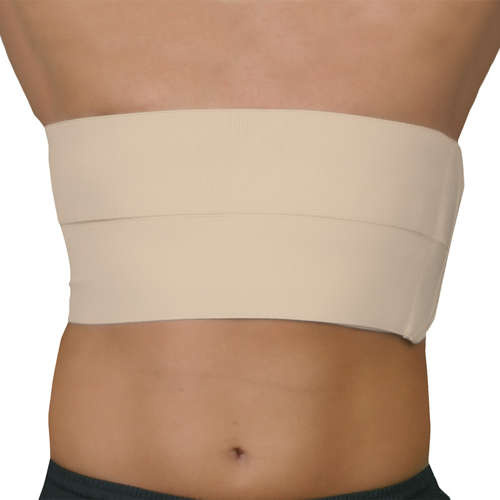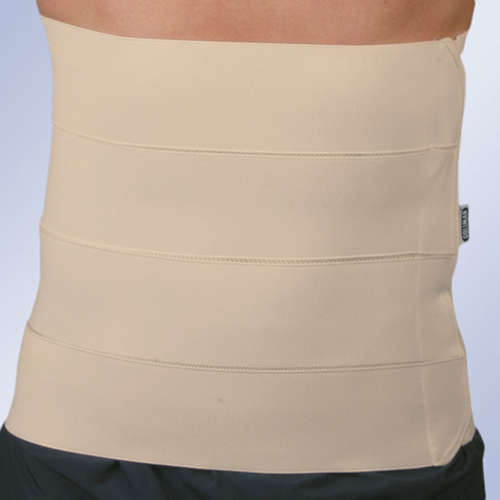How are rib fractures and broken ribs treated?

Whether you’ve sustained a rib fracture or have broken a rib, you need to visit a healthcare professional for medical attention. But what does the treatment process actually look like? Will you need to lay in bed for the next 6 weeks? Continue reading to learn more.
The ribs are an integral part of the body that houses the respiratory and cardiovascular systems, and the internal thoracic organs as well. Prior to diving into the various types of rib injuries, it is essential to first understand the functioning of the ribs. As you’re probably well aware, they’re constructed to protect your inner organs, but also play a role in breathing - the rib cage expands outward to allow for lung inflation.
Ribs come in two different types of classifications - atypical and typical, and are arranged in 12 pairs, each of which is attached to a vertebrae (the ribs). The typical variant consists of three parts, a neck, head and body and has a generalised structure. Atypical ribs on the other hand may be thinner, wider, have one facet or no neck, which makes them differ significantly from their typical counterparts.
What are the different types of rib injuries?
During normal functioning, the ribs expand outward during breathing, which is supported by muscles and ligaments surrounding the rib cage, as well as costal cartilage. If you’ve sustained injuries to the chest or ribs, you may experience a number of symptoms including pain when taking deep breaths or during sneezing, coughing, crunching sounds, muscle spasms of the rib cage, difficulty breathing and noticeable injuries (indentions in the skin and bruising)(Rib injuries).
Rib injuries are typically caused by blunt force, which may be due to a car accident, falling from great heights, being crushed under a heavy weight or during contact sports. Some of the less-severe injuries to the rib cage and surrounding areas are:
- Bruising - caused by ruptured blood vessels and may be a warning sign of a potential fracture or break.
- Intercostal muscle injury - these are the muscles which move your rib cage up and down, and may be strained due to rigorous twisting, often during sports such as golf, tennis or baseball (Rib injuries).
- Costochondral separation - this occurs when one or more ribs are torn loose from the costal cartilage, thus detaching from the sternum (Rib injuries).
Our ribs don’t get as much credit as they should - not only are they excellent at protecting our lungs, heart and other organs, they synchronize with our breathing patterns by expanding outward with every breath we take. And due to their curvature, they’re less prone to fractures and breaking - however, this does occur (Rib injuries). Just like any bone in our bodies, with enough pressure and weight being put on it, our ribs can be damaged.
In the case of rib fractures, they often result in a direct blow to the chest, but in some situations, they may even be caused by something as minor as a hard cough - though in such cases, underlying conditions such as osteoporosis may be to blame. Rib fractures can be either a crack or a break in one of the bones, which causes pain around the area of the damaged rib and when you take deep breaths.
Additionally, it’s important to note that not every broken rib or rib fracture is the same - they come in 3 groups which are non-displaced (a crack in the bone that hasn’t shifted), displaced (when the bone is broken and there is space between the parts) and complex (where there is more than one break in a single bone) (Researchgate). It’s important to note that each of these groups include different types of breaks and fractures, including transverse (a vertical crack or break), oblique (a more horizontal crack or break), wedge (a crack or break which is in the shape of a wedge), comminuted (a rib that is broken into a few, localised pieces) and segmental (a break in two parts of the rib, which are further away from one another) (Researchgate).
Although a fractured or broken rib can cause pain and difficulty breathing, flail chest is much worse. This occurs when three or more ribs are broken in two places, front and back (Rib injuries). The flail chest injury creates abnormal air pressure in the lungs, which causes them to work in reverse - instead of having the rib cage lift outwards during breathing, it sinks (Rib injuries).
Treatment options
In order to receive proper treatment, it is essential that you consult with a doctor and seek medical advice if you’ve been in an accident and experience pain during breathing or around the area of your injury, as well as any bruising or indentations around the affected area. Your doctor will do a physical exam by pushing on your chest to find the injury, may listen to you breathe, check your heart rate and look over your belly, chest and neck for signs of injuries. Although you’d think that an X-ray would be the first step in the diagnosis, small fractures don’t always appear in X-ray results, only more obvious breaks (Rib injuries). Additionally, your doctor might take a CT scan or MRI to find fractures or breaks that didn’t appear on the X-ray results (Do I have a Broken Rib?).
A small fracture takes around 6 weeks to fully heal and doesn’t require any complicated treatments. In most cases, simply taking a break from any rigorous activities, putting an ice pack on the injury and taking pain medication (Do I have a Broken Rib?). However, if you have broken ribs that are protruding outwards, they may damage your inner organs - in such situations, you may have to undergo surgery. Putting excess pressure on the ribs isn’t advised, as it can restrict your breathing, but a reliable rib belt (one that doesn’t restrict your breathing) can help get broken ribs treated.
Choosing a rib belt
Rib belts are elastic straps that go around your upper torso and help to reduce muscle pain, speed up the process of recovery after chest surgery and help in the treatment of rib fractures. Before tossing a rib belt into your shopping cart, it is vital that you speak with your doctor, who will provide medical advice and decide if your condition can be treated with this product.
These belts work by stabilizing the chest and specific ribs, depending on the model that is recommended for your condition. Rib straps come with a number of bands - the more bands, the more coverage on your body. This product can support either the lower ribs, the entire chest, as well as the abdominal area. If you have multiple broken ribs, a rib strap with three or four bands might be a good option for you. Rib belts are made of inelastics and various stretchable materials, and include soft linings, which prevent skin irritation and any damage to - all while properly stabilizing the entire body.
If you’re looking for an additional option for reducing pain caused by a rib fracture, to stabilize your chest area or to accelerate the recovery process, speak with your doctor and ask if a rib belt is right for you.
Sources:
- “Rib injuries”, The State of Victoria and the Department of Health & Human Services, June 2011 https://www.betterhealth.vic.gov.au/health/conditionsandtreatments/rib-injuries
- “The Ribs”, Oliver Jones, February 10, 2020
https://teachmeanatomy.info/thorax/bones/ribcage/#:~:text=The%20ribs%20are%20a%20set,protect%20the%20internal
%20thoracic%20organs. - “Fractured Rib”, Healthwise Staff , June 26, 2019 https://www.uofmhealth.org/health-library/zt1003spec#:~:text=A%20rib%20fracture%20is%20a,bone%20itself%20is%20not%20broken.
- “Rib fractures after blunt thoracic trauma in patients with normal versus diminished bone mineral density: a retrospective cohort study” Prins, Jonne Thomas, Lieshout, Esther, Reijnders, M., Verhofstad, Michiel, Wijffels, M., 2019/12/01 https://www.researchgate.net/figure/Classification-of-rib-fractures_fig2_337909877
- “Do I have a Broken Rib?” WebMD, 2018 https://www.webmd.com/a-to-z-guides/do-i-have-a-broken-rib#1



